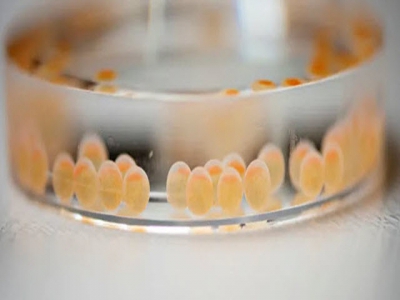Breeding breakthrough can combat CMS

Salmon farmers can hope to reduce the number of mortalities caused by cardiomyopathic syndrome (CMS), following the discovery of genetic markers that should allow the production of salmon strain that are more resistant to the disease.
Salmon eggs selected for resistance to CMS can improve survival rates considerably. Photo © Jon-Are Berg-Jacobsen, Nofima
The late onset of the disease, which can cause high mortalities when salmon are around 3-5 kilos, leads to high economic losses, and was regarded as the most serious fish disease in Norwegian aquaculture by fish health personnel, according to a Fish health report in 2017.
However, research into a CMS outbreak at a Marine Harvest site in Norway indicates that genetic markers on two chromosomal regions might confer stronger survival and robustness to the disease.
Analyses by Nofima and Marine Harvest showed that there is a genetic variation for CMS resistance. Selection of stronger and resistant individuals or families using genetic QTL markers would help to reduce mortalities caused by CMS, or due to underlying stress reasons during disease outbreak.
The results of this study are part of the SalmoResist research project that is funded by the Research Council of Norway and is led by Nofima. The project has two industrial collaborative partners: Marine Harvest and SalmoBreed. One of the goals of this project is to utilize data from natural field outbreaks of diseases for QTL detection, and to use this information for selection of broodstock.
Scientists from Nofima and Marine Harvest set out to sample fish from field outbreaks due to viral diseases during the 2016/17 farming season. When a field outbreak of any disease was reported, veterinarians were asked to confirm the disease through clinical signs and symptoms as well as qPCR analysis. Once the specific cause of each outbreak was determined, dead fish were collected over a short period to limit the potential of sampling fish that were not dying due to the disease of interest.
At the end of the production cycle, an equal number of survivors were sampled during slaughtering. A few of the sampled survivors are also investigated by veterinarians to confirm that they were potentially healthy. All fish were genotyped and analysed for QTL, which finally led to the detection of two QTL regions for CMS.
The QTL analysis was undertaken by Solomon Boison - then at Nofima, now Marine Harvest - who said: “The two QTL regions explained about 50 percent of the genetic variation of resistance to CMS and therefore will go a long way to help the industry select fish that will be resistant to the virus that causes CMS.”
Luqman Aslam, a researcher of Nofima, is very pleased that the field outbreak results were further verified by challenge tests conducted by the industry partners at the end of 2017. He thinks that the QTL-findings, which explain large proportions of genetic variance, might allow breeding companies to opt for the efficient and cost-effective marker-assisted selection.
“That will be a game-changer in the fight against CMS,” he says.
Both Marine Harvest and SalmoBreed have validated the QTL identified in the SalmoResist project by performing challenge tests developed by Veso Vikan. The results from the two breeding companies point to the same chromosomal region.
Matthew Baranski from Marine Harvest finds the approach used by the project exciting. He said: “Instead of waiting for challenge models to be developed in the laboratory for some of these diseases, field data could be the first starting point until laboratory models are fully developed, refined and validated.”
Borghild Hillestad from SalmoBreed said: “The findings are very important, especially since they make the breeding companies able to utilize the associated genetic markers with much higher confidence.”
Her colleague Hooman Moghadam added: “In the future, however, to make the best out of such field outbreaks, we need to improve strategies to be able to better account for various sources of noise, error and unknown factors that are inherent part of these type of data collection”.
Nofima will seek to adopt the approach used in this study to help uncover QTLs for other traits instead of going through a challenge test model, especially for diseases with no challenge test models at all. However, care must be taken by confirming outbreaks by veterinarians before sampling.
Có thể bạn quan tâm
 Yeast-protein use may provide fishmeal alternative for trout feeds
Yeast-protein use may provide fishmeal alternative for trout feeds Use of a yeast-based protein and synthetic amino acids can maintain trout growth when replacing fishmeal, but more work is needed to understand the ingredients
 Super grouper: advances in RAS production in Asia
Super grouper: advances in RAS production in Asia Despite being overfished in China and South East Asia, a suite of advances in sustainable aquaculture of a number of grouper species is bringing benefits
 Lumpfish threatened by salmon sector
Lumpfish threatened by salmon sector Lumpfish – which are currently largely derived from eggs obtained from wild-caught broodstock – are widely stocked in salmon farms in order to remove parasitic